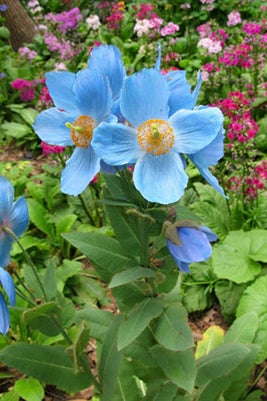
Quick facts
Common name - Himalayan poppy
Botanical name - Meconopsis
Group - Perennial
Flowering - Summer
Planting time - Spring
Height and spread - 1.2m (4ft) high 50cm (20in) spread
Aspect - Shade
Hardiness - Hardy
Difficulty - Difficult
Cultivation notes
Meconopsis grow best in the cooler and wetter areas of Northern England and Scotland and are a challenge in the South. Even a few days of bright sun in dry conditions will scorch plants in unsuitable sites.
They require a humus-rich, moist but well-drained, slightly alkaline to slightly acid soil. More important than the is that the soil has plenty of organic matter. Site plants in partial shade with shelter from cold, drying winds. They are particularly suited to woodland gardens but also do well in moist, shaded beds.
Never allow plants to dry out during the summer months. Apply a balanced fertilizer, such as Growmore, at 35g per sq m (1oz per sq yd) in spring and mulch round plants with garden or well-rotted manure.
Propagation
Plants can either be propagated by division or raised from seed or, in the case of some species, by both. Division is best done in spring at the first signs of growth.
A suitable sowing medium for seed is two parts multipurpose peat-free to one part , passed through a sieve. Meconopsis seed requires light to germinate so either surface sow and cover with a thin layer of to anchor seeds and prevent drying out or, alternatively, top off the pot with damp perlite and sow the seed into this.
Meconopsis seed has short term viability. Late summer and autumn sowing gives best in about three weeks but then need to be overwintered in a or similar. Sowing in February allows a full for the young plants to develop unchecked but it is important to store the seed overwinter in cool, dry conditions in the bottom of a domestic refrigerator.
As pot-grown seedlings develop the first pair of true leaves they should be pricked off into containers of a similar medium to that detailed above. Many seedlings are lost when pricking out. To avoid this sow a tiny pinch of 3-5 seeds into each module of a plug tray. Once plants have germinated they can be potted on in a group without any disturbance.
Seedlings need careful watering as excessive wetness or dry conditions can both be fatal. seedlings should be fed with a weak liquid feed every fortnight during the growing season. A covering of horticultural fleece will reduce and the possibility of scorch from bright sun and will also protect against frost.
Pot on regularly as the seedlings develop to avoid a check in their growth and plant out in the autumn or the following spring.
Cultivar Selection
Although usually associated with blue flowers, the colour range of meconopsis includes red, pink, white, yellow and purple. The foliage of many species is also attractive, forming bold overwintering covered with silver or gold hairs.
Meconopsis baileyi AGM: the classic sky-blue Himalayan poppy (often sold as M. betonicifolia) with flowers 8cm (3in) across in June and July.
M. ‘Lingholm’ (Fertile Blue Group): larger flowers to 10cm (4in) of deep sky-blue colour
M. ‘Slieve Donard’ AGM (Infertile Blue Group): large, nodding, sky-blue heads. Similar to ‘Lingholm’ but propagated only by division
M. napaulensis: produces mounds of bold evergreen foliage for two or three years before flowering in shades of red and yellow on stems 1.2m (4ft) high. It is monocarpic. Most plants in cultivation and any seed offered are likely to be hybrids.
Problems
Damping off is common where seed is sown too thickly.
Plants dry at the roots or in too bright and exposed a position are prone to scorching of the leaves.




